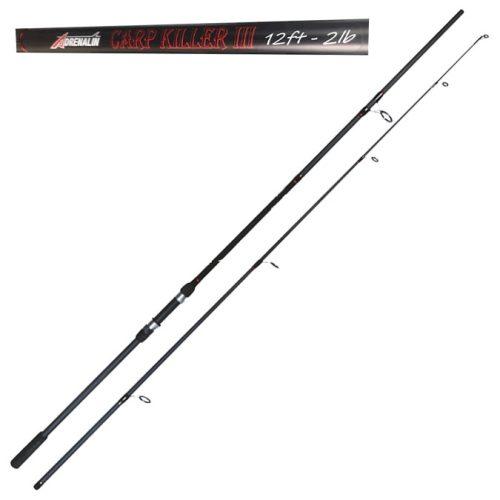Carp fishing is a rewarding mix of patience, technique, and the right gear. When you combine a carp killer rod with a Tripod fishing stand, you’re setting yourself up for better control, improved comfort, and a higher chance of landing big fish. Whether you're new to the sport or looking to refine your setup, this guide will walk you through the essentials to get the most out of your fishing experience.
Why Use a Carp Killer Rod and Tripod Fishing Stand?
Strength and Sensitivity in One Rod
A carp killer rod is built to handle the unique challenges of carp fishing. With lengths typically ranging from 12 to 13 feet, these rods offer the casting power and precision needed to reach deeper waters where carp love to hide. They're also sensitive enough to detect subtle bites, which is key when targeting cautious fish.
Stability That Works Anywhere
The Tripod fishing stand offers solid, adjustable support for your rod, making it ideal for uneven or muddy banks. Its three-legged design spreads out weight evenly and keeps your rod secure—even when you're dealing with strong wind or aggressive bites. It also allows for hands-free operation, so you can prep bait, relax, or monitor multiple rods at once.
How to Set Up Your Gear for Success
1. Choose the Right Fishing Spot
Pick a location near weed beds or deeper water—places where carp tend to feed. Ensure the ground is firm enough to support your tripod without slipping or sinking.
2. Set Up the Tripod Fishing Stand
Unfold your Tripod fishing stand, extend the legs, and adjust them so the stand is level. Set the height so that the rod tip will sit around 60–80 cm off the ground—ideal for clear visibility and easy casting.
3. Prepare Your Carp Killer Rod
Attach your reel and thread the line through the guides. A 12–15 lb test line is a solid choice for most South African waters, where carp commonly weigh between 5 and 15 kg. Add your hook, bait, and you're good to go.
4. Mount the Rod on the Tripod
Place the rod securely into the holder on the tripod. Adjust the angle so your bait lands exactly where you want it. Many tripods come with tilting heads, making it easy to fine-tune your setup.
5. Anchor and Secure
If you're fishing on soft or windy terrain, anchor the legs of the tripod with stakes or weights. This extra step helps prevent tipping. You can also add bite alarms or visual indicators to alert you the moment a fish takes the bait.
Pro Tips for Better Fishing
-
Practice Your Cast: Learn how your carp killer rod behaves at different distances and weights.
-
Stay Weather-Aware: Adjust your setup depending on wind or rain conditions.
-
Keep Your Gear Clean: Rinse off your stand and rod after each session to prevent rust and wear.
-
Use Bite Alarms: They’re a great addition for long sessions or when you’re using multiple rods.
-
Stay Taut, Not Tight: Keep your line firm, but not overly tight—it helps detect subtle bites.
Why This Setup Makes a Difference
Better Stability, Better Results
The Tripod fishing stand keeps your rod steady, which helps with bite detection and reduces missed opportunities.
Comfort Over Long Sessions
With adjustable height and a secure rest, you’ll avoid strain on your hands and back—key during long hours by the water.
Higher Catch Rates
Precise casting and secure setups mean your bait stays where it needs to be—and your response time is faster when a carp bites.
The Carp Fishing Scene in South Africa
Carp fishing has grown in popularity in South Africa, and for good reason. With over 100 million carp in local waters and a booming gear market generating an estimated R1 billion annually, it’s a great time to be part of the scene. Top spots include the Vaal River, Hartbeespoort Dam, and the Orange River.
FAQs
What’s the ideal height for a Tripod fishing stand?
Adjust it so your rod tip is around 60–80 cm from the ground. This gives you the best angle for casting and watching your line.
Can I use any rod with a tripod stand?
You can, but a carp killer rod is specifically designed for the power and sensitivity of carp fishing demands. It pairs well with a Tripod fishing stand.
How do I maintain my gear?
Rinse with clean water after use, especially if you've been in muddy or salty conditions. Lubricate the reel and check for any wear on your tripod joints.
Should I always anchor the tripod?
Yes, especially in soft ground or windy conditions. It keeps your setup stable and prevents rod movement.
What line strength should I use?
A 12–15 lb test line is a good standard for South African carp, which are often strong fighters.
Summary
Combining a carp killer rod with a Tripod fishing stand gives you the control, stability, and comfort needed for successful carp fishing. From proper setup to maintenance and pro tips, the right gear can significantly boost your chances of landing a trophy fish. With South Africa's carp-rich waters, there's no better time to gear up and cast out.



